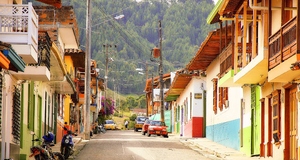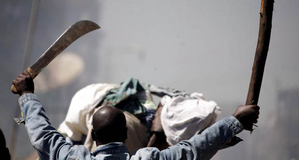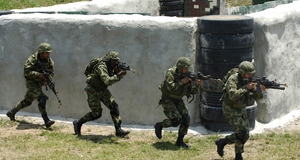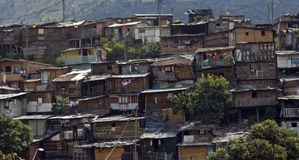From Cornell International Affairs Review VOL. 8 NO. 2Colombia's Opportunity for Transitional JusticeThe FARC TodayThe government has taken steps toward transitional justice over the past 15 years. Even though the FARC is still the largest rebel group in Latin America, its power has diminished since 2008. After the deaths of two major leaders, Marulanda in 2008 and Mono Jojoy in 2010, the FARC was severely weakened. Estimates suggest that their membership dropped more than half since 2001, with somewhere around 8,000 members 24. Former president Alvaro Uribe’s offensive attacks from 2002 on have only further weakened the FARC and included five high profile hostages who were rescued from the FARC. The most significant step towards achieving peace, however, is the peace talks that began in 2012. The Santos administration’s peace talks are the first attempt of this kind in a decade, and the fourth try in the last thirty years 25. According to the International Crisis Center, a transitional justice regime cannot occur until human right violators are prosecuted and victims gain reparations 26. In 2013, the agenda for negotiations still lacked several aspects ofa transitional justice regime, including reparations and accountability mechanisms for individuals 27. However, I estimate that a resolution between the FARC and the government will not be reached for a number of years. Both the Colombian government and the FARC have publicly admitted to the challenges of agreeing on a solution that both parties approve. The international community has indeed become involved in this conflict. A prime example is the United Nations Development Programme’s Transitional Justice Programme, which not only assists the government in transforming itself but also provides education workshops to locals about their rights as victims 28. Venezuela, Chile, Cuba, Norway, and U.S. are among some of the countries that support the peace talks 29. The road to achieving transitional justice is not easy nor fast, and these peace talks will not necessarily signal the achievement of transitional justice. Even if the talks include more elements of transitional justice, there must be accountability for government and non-state actors in order to achieve true implementation. Mechanisms must be established in order to prevent the corruption that has impeded democratic stability in the past from continuing to keep the Colombian state as an illiberal democracy. The first step towards this goal is for both parties to lay out a road map for the future that ensures long-lasting effects for the country. The plan should not be too ambitious but instead remain possible to implement such as previous laws like the Justice and Peace Law of 2005. UP TodayUP, the political party created by the FARC in 1985, grew in its beginning states, yet most of its members were killed by people who feared UP’s leftist ideologies. Today, UP technically still exists, but it is very weak. One of the ways the government addressed the past political killings was by making an exception for UP and allowing them to be considered a political party even though their numbers were extremely scarce. In 2002, UP was banned from political participation, but in 2013, the Colombian Peace Commission allowed the UP to participate 30. The new UP party differs from the old UP party as its members do not have the strength to stand on their own. Instead of running as an independent party, UP members have merged with similar political parties who have more standing in today’s politics. In 2014, UP party candidate Aida Avella, who had been an UP asylee in Switzerland for almost two decades, ran as the vice presidential candidate for the Alternative Democratic Pole, a more prominent leftist party in Colombia. Running as vice president gave her greater chance of succeeding in politics. This leftist party received 2 million votes, which is a significant increase from the 50,000 they had had in 2002. This election demonstrated that even though UP is pretty much non-existent today, its members are aligning themselves with other similar parties in order to continue being involved in politics. Colombia’s FutureOn October 20, 2014, the District Attorney stated that 34 of the UP murders in the 80s and 90s were considered crimes against humanity 31. However, no prosecution decisions have been made so far. While progress is indeed being madeit is important to note that violence and threats against UP members still continue today on a smaller scale. Around 200 members of UP dis- appeared or were killed during Uribe’s term 32. In 2012, leftist Congressman Ivan Cepeda and nine other related members received death threats from the paramilitaries. Since the attempts to disband the paramilitaries in 2006 were not successful, their goal of eliminating leftist ideals by violence and murder continues. The direct and clear threats of annihilation of the “guerilla groups,” which they associate with these political leaders, demonstrate that the violence of the 1980s has not disappeared from Colombia. While the government might be making progress toward changing their institution themselves, other forces have not changed their past views on how to get rid of opposing political ideologies. The parallels to the 80s are daunting. In the 80s, peace talks were attempted, violence erupted, massive killings occurred, and a prominent leftist party was annihilated. Currently, peace talks are being attempted once again, yet the change is that the Colombian government is much stronger than before. However, what Colombian society refers to as the “dark forces” still remain. These dark forces, extreme rightists, paramilitaries, corrupt government officials, et cetera are still a clear threat to the transition to transitional justice today. The transition failed in the past, and if these “dark forces” overtake the system and once again commit crimes against humanity towards the newly emerging left, the current transition will fail. Colombia’s situation differs from the 1980s by the fact that the FARC has made an attempt at formal peace talks, and all signs point to seeking a peace resolution now more than ever before. ConclusionColombia’s long history of democracy has never signaled a true democracy or respect of human rights. Due to the internal conflicts between the government, FARC, leftist political groups, and paramilitaries, thousands of people have fallen victim to human rights violations, which have not been prevented by the government. The thousands of murders of UP members by the government and other groups prevented the achievement of transitional justice and any attempts at peace talks during this time. Currently, internal conflicts are still very much alive within Colombia, but the chance of transitional justice is available to them once again. The different factor is that today, the FARC has finally showed an interest in a formal and more thorough framework for peace. Colombia is at a critical point in time: progress towards transitional justice is indeed an exciting possibility. Nonetheless, if the “dark forces” resort back to massive exterminations and genocide in order to suppress opposing political views, then the attempted transition to transitional justice will fail like it did in the 1980s. References“Analysis Framework.” Office of the UN Special Adviser on the Prevention of Genocide. (Accessed 23 October 2014). Beittel, J. S. 2014. “Peace Talks in Colombia.” Congressional Research Service (April): 1-35. Cardenas, M. S. 2007. “Economic Growth in Colombia: A Reversal of Fortune?” Fedesarollo Working Paper Series (February): 1-36. Center for Justice and International Law. 2006. Revista Cejil 2: 1-165. El Plan Baile Rojo – La historia sobre el genocidio contra la Union Patriotica. (2011). Video file. Freeman, Daniel. 2014. Union Patriotica, Patriotic Union. Colombia Reports. (Accessed 24 October 2014). “Genocidio de la UP: Fiscalía declaró 34 homicidios contra miembros de la UP como crímenes de lesa humanidad [Genocide of the UP: District Attorney declared 34 homicides against the UP as crimes against humanity]” October 20, 2014. El Espectador. Helping the Victims: United Nations Developing Programme. 2014. Helping the Victims of Colombia’s Conflict. Hiskey, J. (2014). Latin American Politics. Lecture presented in Political Science course at Vanderbilt University, Nashville, TN. International Center for Transitional Justice. 2014. Colombia. International Center for Transitional Justice. 2014. What is Transitional Justice. International Crisis Group. 2014. Transitional Justice and Colombia’s Peace Talks. (Accessed 20 October 2014). Marshall, M. G. 2014. Polity IV Project. (Accessed 28 October 2014). Summers, Nicole. 2012. “Colombia’s Victims’ Law: Transitional Justice in a Time of iolent CoVnflict?” Harvard Human Rights Journal 3: 219-235. United Nations Regional Information Center. 2014. The Guerilla Groups in Colombia. (Accessed 22 October 2014) Endnotes
Suggested Reading from Inquiries Journal
Inquiries Journal provides undergraduate and graduate students around the world a platform for the wide dissemination of academic work over a range of core disciplines. Representing the work of students from hundreds of institutions around the globe, Inquiries Journal's large database of academic articles is completely free. Learn more | Blog | Submit Latest in International Affairs |



















